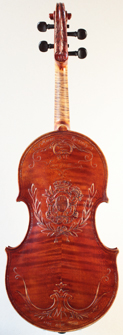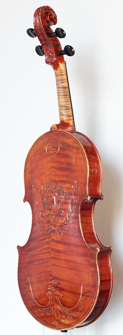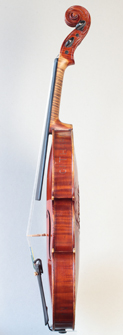Several aspects of this violin by Marius Richelme defy tradition, notably:
pattern, size, and decorations.
1. The viol-like shape developed and patented by Richelme in 1869 is quite convincing.
Isn't it a Guarneri "del Gesù" pattern pushed to its limits?
Recent research has shown that long soundholes improve tonal output. *
2. The huge body size of 37.1 cm increases bass resonance without impeding playability,
thanks to sloped shoulders and a normal 19.5 cm diapason.
3. I love the sculpted ornaments.
They anchor the violin
geographically (coat of arms of Marseilles),
historically (names of past master makers),
biologically (made of plants), and
spiritually ("Jubilate Deo").
Before you start playing, you're reminded of your place in the Universe!
It's fascinating that this bold design comes from someone with perfect classical technique.
This isn't the whim of an eccentric, but the well-thought-out realization of an expert.
Plate arching, edgework and especially varnish are first-class.
Large Violin by Marius Richelme, Marseilles, France, 1875
|
|
|
| |||||||||||||||
Description — Inventive

"JUBILATE DEO IN CITHARA"
is engraved on the ribs around the violin.
"Sing praises to the Lord with the harp" (Psalm 98:5).
Setup — To Restore or Not?
Bringing back to playable condition an instrument that was left asleep
for a long time raises many issues.
On this Richelme, I was determined to do as little as possible,
but as much as necessary to have a good idea of the tone.
Shaving wood or opening the violin was out of the question,
so my luthier and I decided to keep "as is"
the trenched fingerboard, the upper nut with string grooves too far apart,
the bulky neck set sideways, the no-longer-adjusted tuning pegs, etc.
We only replaced the removable parts that are paramount for sound production:
strings, tailgut, bridge and soundpost.
As far as comfort goes, I've got other violins to play in concerts
(and don't perform virtuoso pyrotechnics anyway).
Now I feel relieved that the responsibility of irreversible transformations lies with its next owner.
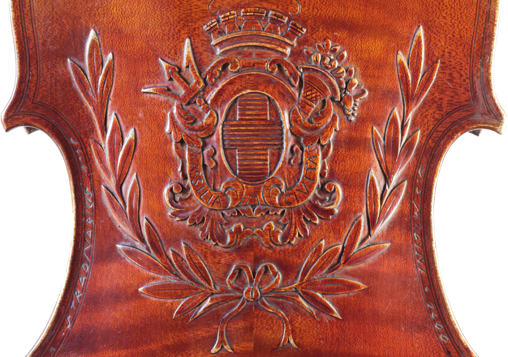
The maker carved the motifs directly into the plate —
rather, carved the plate around the motifs.
"MASSILIA CIVITAS" means City of Marseilles. Its coat of arms includes a blue cross (the city's flag), a trident (representing sea and travel), and a horn of plenty (representing abundance). A large olive wreath cradles it.
"MASSILIA CIVITAS" means City of Marseilles. Its coat of arms includes a blue cross (the city's flag), a trident (representing sea and travel), and a horn of plenty (representing abundance). A large olive wreath cradles it.
Tone — Grand
So? Does it sound as good as Richelme claimed? Yes and no.
What I find fantastic about this violin is that it has the deep and wide tone of large instruments
without the somber character that's associated with the Maggini pattern.
In fact, I had never played a very large violin with such a joyful personality.
The timbre is ravishing and composed of intense primary colors.
I recognize some French quality of sound in it.
The core of the tone is well focused and sparkling, while a sort of fuzzy halo surrounds it.
It is very powerful indeed, and I have yet to find its limits.
So yes, it sounds great, but no, not better than the finest violins ever made.
History — Experimental 19th Century
The 1800s were the era of inventions:
photography,
bicycle,
pasteurization,
telephone,
internal combustion engine,
electric light,
plastic,
you name it.
In the French musical world, when Richelme built our violin in 1875,
Adolphe Sax had already invented the saxophone,
and Jean-Baptiste Vuillaume the octobass and the self-rehairing bow.
New shapes for the violin had been patented by
Félix Savart (trapezoidal violin)
and François Chanot (guitar-shaped violin), among others.
Viewed in that context,
Marius Richelme's work fits right in.
It must have been exciting being surrounded with creative people enthused by
a pioneering spirit.
To me, this fearless violin embodies open-mindedness and self-confidence.
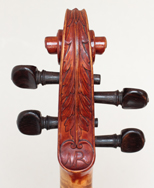 |
 |
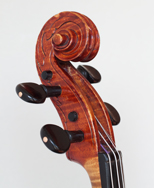 |
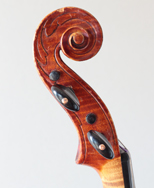 |
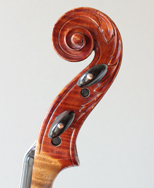 | ||||
| Acanthus leaves cover this scroll as if it was born of them, like a fern scroll. The treble-side pegs are markedly worn out, a sign this violin was mostly played before the advent of fine tuners. | ||||||||
Bibliography
* "Power Efficiency in the Violin" on MIT.edu by Jennifer Chu, MIT News Office, 10 February 2015.
Written by Marius Richelme:
- "Études et Observations sur la Lutherie Ancienne et Moderne" on Babel.HathiTrust.org by Marius Richelme, Canquoin, Marseilles, France, 1868.
- "Renaissance du Violon & de ses Analogues" on URResearch.Rochester.edu by Marius Richelme, Doucet, Marseilles, France, 1873.
- "The Collection Thys de Castella" on MuseoDellaMusica.com
by Emiliano Marinucci, B4Baroque, Foligno, Italy, 2016,
page 9.

- "The Brompton's Book of Violin and Bow Makers" on Amati.com by John Dilworth, Ed. John Milnes, London, 2012, page 502.
- "A Dictionary of Violin Makers" on Archive.org by Cecie Stainer, Novello, London, 1896, page 77.
- "Les Luthiers Français" by Loïc & Verena Le Canu, tome 2,
L & V Le Canu, Paris, 1994, pages 62-65.

- Violin by Marius Richelme, 1867,
on Bromptons.co.

- Violin by Marius Richelme, 1869, and biography on Corilon.com.

- Cello by Marius Richelme, 1873,
on BALaT.Kikirpa.be.

- Violin by Marius Richelme, 1874,
on CollectionDuMusee.PhilarmonieDeParis.fr.

- Viola by Marius Richelme, 1887,
on BALaT.Kikirpa.be.

- Marius Richelme on FaceBook.com.

- "Universal Dictionary of Violin and Bow Makers" by William Henley, Amati Publishing Ltd, Tunbridge Wells, England, 1973, reprinted 1997, page 963.
- "Encyclopedia of Violin-Makers" by Karel Jalovec, volume 1, Paul Hamlyn, London, 1968, page 199.
- "Die Geigen- und Lautenmacher vom Mittelalter bis zur Gegenwart" on Archive.org by Willibald von Lütgendorff, volume 2, Frankfurter Verlags-Anstalt, Frankfurt am Main, Germany, third edition, 1922, page 414.
- "Le Violon" by Émile Leipp, Hermann, Paris, 1965, pages 35 & 38.
- "Les Ancêtres du Violon et du Violoncelle" on Archive.org by Théodore Dubois, vol. 2, Charles Schmid Éditeur, Paris, 1901, pages 371-372.
- "Dictionnaire Universel des Luthiers" by René Vannes, volume 1, Les Amis de la Musique, Brussels, second edition, 1951, page 300.
Measurements & Data
Maker: Antoine Marius Richelme (1833-1896)
Made in: Marseilles, France
Year: 1875
Back Length: 371 mm *
Upper Bouts: 169 mm *
Middle Bouts: 123 mm *
Lower Bouts: 210 mm *
Stop Length: 195 mm
Rib Height at Neck: 31 mm *
Rib Height at Endpin: 32 mm *
Thickness of the Top: 3.2 mm
Thickness of the Back: 4.0 mm
F-hole Length: 93.1 mm *
Distance Between F-holes: 41 mm *
Distance Edge-Purfling: 3.5 mm
Scroll Width: 43 mm *
Weight: 462 grams
Label:
Par Mus. (MR) RICHELME
BREVETÉ
Études et Observations sur la
Lutherie ancienne et moder-
ne 1868. Renaissance
du Violon et de ses analogues
1873. L'art du facteur d'ins-
truments à archet en Préparation.
Richelme
FAIT À MARSEILLE 1875 COMPOSITION
Label Translation:
By Mus. (MR) RICHELME
PATENTED
Studies and Observations on
ancient and modern Violin-
making 1868. Resurgence
of the Violin and its family
1873. The art of the bowed
instruments' maker in Preparation.
Richelme
MADE IN MARSEILLES 1875 COMPOSITION
Inscription: To the inside back,
"Fait a Marseilles
en 1875
MRichelme."
Inlay: Two rows of purfling on belly and back.
Carving: Sculpted leaves on the scroll and back. Several text engravings:
Condition: Not a single crack. Varnish in fine condition. No repairs. Original neck and neck set. Fingerboard, saddles, pegs, tailpiece, button, and bassbar might be original.
Restoration: Béatrice de Haller, Carouge, Switzerland, 2017.
* measured with a caliper
Maker: Antoine Marius Richelme (1833-1896)
Made in: Marseilles, France
Year: 1875
Back Length: 371 mm *
Upper Bouts: 169 mm *
Middle Bouts: 123 mm *
Lower Bouts: 210 mm *
Stop Length: 195 mm
Rib Height at Neck: 31 mm *
Rib Height at Endpin: 32 mm *
Thickness of the Top: 3.2 mm
Thickness of the Back: 4.0 mm
F-hole Length: 93.1 mm *
Distance Between F-holes: 41 mm *
Distance Edge-Purfling: 3.5 mm
Scroll Width: 43 mm *
Weight: 462 grams
Label:
Par Mus. (MR) RICHELME
BREVETÉ
Études et Observations sur la
Lutherie ancienne et moder-
ne 1868. Renaissance
du Violon et de ses analogues
1873. L'art du facteur d'ins-
truments à archet en Préparation.
Richelme
FAIT À MARSEILLE 1875 COMPOSITION
Label Translation:
By Mus. (MR) RICHELME
PATENTED
Studies and Observations on
ancient and modern Violin-
making 1868. Resurgence
of the Violin and its family
1873. The art of the bowed
instruments' maker in Preparation.
Richelme
MADE IN MARSEILLES 1875 COMPOSITION
Inscription: To the inside back,
"Fait a Marseilles
en 1875
MRichelme."
Inlay: Two rows of purfling on belly and back.
Carving: Sculpted leaves on the scroll and back. Several text engravings:
- On the ribs around the violin,
"JUBILATE DEO IN CITHARA." - On the back between the purflings,
"G . DUIFFOPRUCCAR . 1515
J . P . MAGINI . 1600
JBUS . STAINER . 1660
N . AMATI . 1670
A . STRADIVARIUS . 1715
JRH . GUARNERIUS IHS . 1740." - On the upper back,
"MARIUS RICHELME
DIPLOMATE
munitus
1875
FECIT MASSILIA." - On the coat of arms of the city of Marseilles, "MASSILIA CIVITAS."
- On the lower back, "MR
HOC OPUS MEUM." - On the heel of the scroll, "MR."
Condition: Not a single crack. Varnish in fine condition. No repairs. Original neck and neck set. Fingerboard, saddles, pegs, tailpiece, button, and bassbar might be original.
Restoration: Béatrice de Haller, Carouge, Switzerland, 2017.
* measured with a caliper


